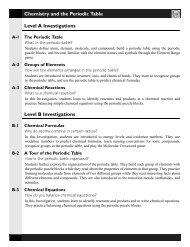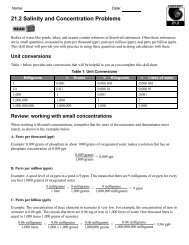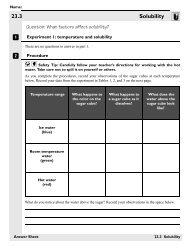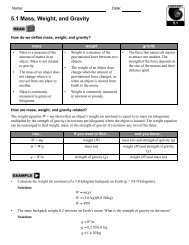You also want an ePaper? Increase the reach of your titles
YUMPU automatically turns print PDFs into web optimized ePapers that Google loves.
Name:<br />
Date:<br />
25.2 Color Mixing with Additive and Subtractive Processes<br />
25.2<br />
The way that color appears on a piece of paper and how your eyes interpret color involve two different color<br />
mixing processes. Your eyes see color using an additive color process. The RGB color model is the basis for how<br />
the additive process works and involves mixing colors of light. The CMYK color model is the basis for how the<br />
subtractive color process works and involves pigments of color which absorb colors of light.<br />
RGB color model<br />
CMYK color model<br />
Primary colors Mixed colors New color Primary colors Mixed colors New color<br />
red red + green yellow magenta magenta + yellow red<br />
green green + blue cyan yellow yellow + cyan green<br />
blue blue + red magenta cyan cyan + magenta blue<br />
How black is<br />
made<br />
How white is<br />
made<br />
Absence of light<br />
How black is<br />
made<br />
How white is<br />
made<br />
Pure black pigment<br />
red + green + blue<br />
Absence of pigment or use of pure<br />
white pigment<br />
• The human eye has photoreceptors for red, green, and blue light. Which of these photoreceptors are<br />
stimulated when looking at white paint?<br />
Solution: All three of these photoreceptors are stimulated equally.<br />
• A laser printer prints a piece of paper that includes black lettering and a blue border. How are these colors<br />
made using the CMYK color model?<br />
Solution: Pure black pigment is used to make the black lettering. If you were to mix the other colors<br />
(magenta, yellow, and cyan), you would only get a muddy gray. The blue border was made by mixing cyan<br />
and magenta pigments.<br />
1. A friend asks you to describe the difference between the RGB color model and the CMYK color model.<br />
Give him three differences between these color models.<br />
2. How would you see the following combinations of light colors?<br />
a. red only<br />
b. blue + red, both at equal intensity<br />
c. green only<br />
d. green + blue, both at equal intensity<br />
3. The color orange is perceived by the eyes when both the red and green photoreceptors are stimulated and the<br />
red signal is stronger than the green. Given this information, what kind of signals would be received by the<br />
eye for the color purple?
Page 2 of 2<br />
4. You see a chair that is painted yellow. Most likely, pure yellow pigment was used to make the paint.<br />
However, explain how your eyes interpret the color yellow.<br />
25.2<br />
5. White paint purchased at a store is often made of a pure white pigment called titanium dioxide. This<br />
white paint reflects about 97% of the light that strikes it. Why might this property of the paint mean that you<br />
interpret its color as white?<br />
6. The image you see on a color TV screen is made using the RGB color model. The image is made of<br />
thousands of pixels or dots of color. Describe how you could make the following pixels using the RGB color<br />
model.<br />
a. A white pixel<br />
b. A black pixel<br />
c. A cyan pixel<br />
d. A yellow pixel<br />
7. What colors of light are reflected and/or absorbed by a red apple when:<br />
a. white light shines on it?<br />
b. only red light shines on it?<br />
c. only blue light shines on it?<br />
8. The CMYK color model works because the combination of pigments absorb and reflect light. Imagine that<br />
white light containing a mixture of red, green, and blue light shines on the combination of CMYK pigments<br />
in the table below. Copy the table on your own paper. Indicate in the blank spaces which colors of light the<br />
pigments absorb and which color is reflected. Some parts of the table are filled in for you.<br />
CMYK color model<br />
Mixed colors Reflected color Which colors of light are absorbed?<br />
magenta + yellow<br />
red<br />
yellow + cyan<br />
blue is absorbed by yellow<br />
red is absorbed by cyan<br />
cyan + magenta<br />
9. If you mix magenta paint and cyan paint, what color will you achieve?<br />
10. A laser printer’s ink only includes the colors cyan, magenta, yellow, and black.<br />
a. Explain how it makes the color green using these pigments.<br />
b. Then, explain what happens for your eye to interpret this color as<br />
green.<br />
c. This Venn diagram illustrates color mixing for the CMYK color<br />
model. Now, make a Venn diagram for the RGB color model. Use<br />
color when you make your diagram. Be sure to label the difference<br />
between the primary colors and the new colors made by mixing.

















